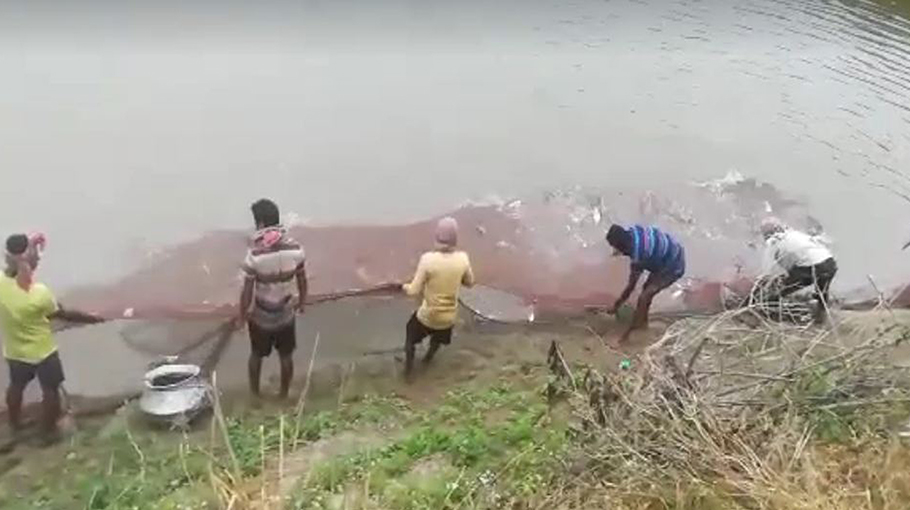Fish production in Chuadanga beats target

Fish farmers, anglers have produced more fish in financial year 2021-22 than the previous fiscal year in 4 upazilas of Chuadanga district as they are very happy to maintain their families to selling the produced. A massive plan has been taken to produce huge amount of fish in the fiscal year of 2022-23 by Chuadanga District Fisheries Department.
It is learnt that a total of 23,741.25 metric tons of fish has been produced by cultivating 6,513.10 hectares of land in fiscal year 2021-22 while 22,836 metric tons of fish was produced by cultivating 6,500.70 hectares of land last financial year. It has become possible when the skill and efficient fish farmers in the district have been showing eagerness in farming the cash product. Over 24,181 metric tons of fish are being expected to produce fish in 2023-24 fiscal year in the district.
Application of modern technology, interests of the farmers having better prices and intensive care of the department of fisheries are mainly liable for the increasing trend in fish cultivation in the district. Officials of Fish Department have been trying with heart and soul for 100 per cent filling the demand of local consumers through fish producers, sources added.
It may be mentioned that production target of fish has been fixed at 24,181 metric tons in 2022-23 fiscal year. Of the total 6249 metric tons are in Sadar Upazila, 5070 metric tons in Damurhuda Upazila, 8012 metric tons in Aladmdanga upazila and 4850 metric tons in Jibannagar upazila.
A according to District Fisheries Officer in Chuadanga, fishermen and fish growers have produced 624.77 metric tons of fish on 1004 hectares of water body in rivers, 3499.18 metric tones on 1525 hectares of beels, 2062.35 metric tons on 523.4 hectares of Baors, 1,364 tones on 1,312 hectares of flood plan (lowland) water and 16,86.93 metric tones of fish on 2,760.70 hectares area of pond, 1468.02 metric tons on 700 hectares of low land and flood plan feild in last 2021-22 fiscal.
Items wise fish production are- 4,577 metric tons of Ruhit, 2974 metric tons of Katla, 2503 metric tons of Mrigel, 575 metric tons of Kalibaus, 811metric tones of Bata, 35 metric tons of Ghonia, 3952 metric tons of silver carp, 1128 metric tons of grass carp, 1047 metric tons of mirror or common carp, 330 metric tons of other and black carps, 1844 metric tons of Pangas, 49 metric tons of Boal or Ayeer, 58 metric tons of koi, 82 metric tons of Magur, 3078 metric tons of talapia, 300 metric tons of thai puti, 1.4 metric tons of kuchia, 47 metric tons of pabda, 13 metric tons of mola, 238 metric tons of other smaller size of fish, 3.5 metric tons of folui and 25 metric tones of shrimp.
It is learnt, 4,356 fishermen and 8426 fish growers including educated youths are engaged in fish cultivation in the district. About 208 fish nurseries have been produced fish fries in 4 upazilas of the district. Besides 5 hatcheries are producing moles.
Fishermen and fish growers said, as the production in rivers are not easy, they are being motivated to the concerned growers to boost production on their ponds and other local water bodies.
Jony Joarder, a fish grower of Bujrukgorgori said, he has cultivated fish on 13 bighas of land along with other educated youths. A few years back they were un-employees but now they are now happy for earning money through cultivation of fish.
Dipok Kumar Paul, District Fisheries Officer (DFO) in Chuadanga when contacted, said as per the government instruction and guideline, they have been motivating fish growers and fishermen including fish farming society members to boost production of fish for meeting demand of local consumers. Aim of the program is to meet nutrition aspect of the consumers as well as strengthen the socio-economic base for the fishermen and fish growers.
He also stated that the fish producers have followed modern technology, used balanced feed and released quality fries in their fish cultivation as production of fish is increasing every year.




